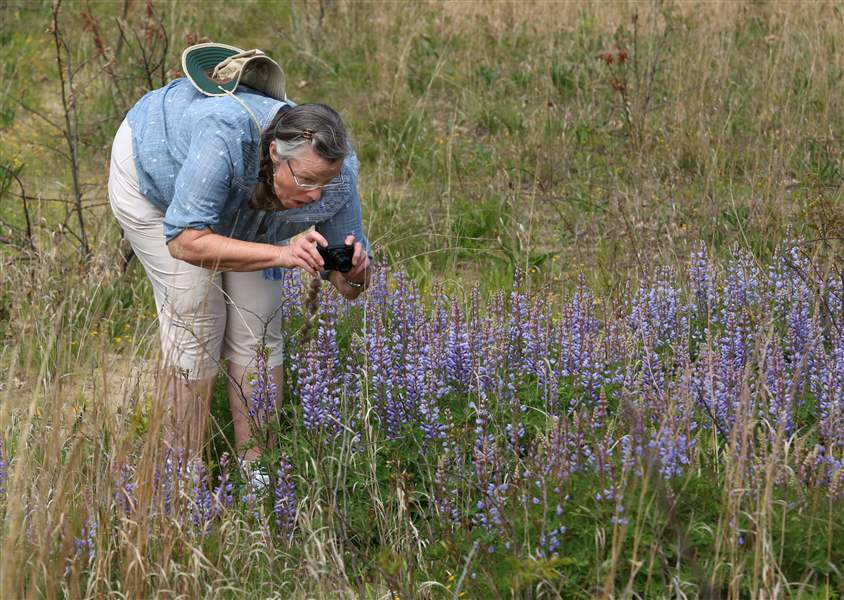
COMMENTARY
Outdoor enthusiasts seeing blue
5/15/2018
Janet Gross of Bellevue, Ohio, photographs Wild Blue Lupine during a tour at Oak Openings Preserve Metropark Tuesday, May 16, 2017, near Whitehouse. The event was part of a Blue Week celebration.
The Blade
Buy This Image
Whether your love for the outdoors has your green-thumbs in a garden, your eyes peeled toward the sky looking for birds, or your feet on the ground covering miles on trails enjoying nature’s beauty, we are fortunate to live in an area designated as “One of the 200 Last Great Places on Earth.” Northwest Ohio and Southeast Michigan is home to the Oak Openings region, a place that is a globally distinct ecosystem designated by the Nature Conservancy.
Who is the Nature Conservancy? This nearly 70-year-old organization leads conservation efforts around the world to protect ecologically important lands and waters for nature and people. As an organization, it addresses the most pressing conservation threats on the largest of scale by the support of more than 1 million members. Its efforts have made an impact in 72 countries, almost 120 millon acres of land and thousands of miles of rivers around the world. The conservation efforts of this organization are felt in our backyards — literally for some and figuratively for all.
Additionally, there are many local organizations and agencies whose passion, mission, and direction is conservation driven and works collaboratively and partners to protect the world we live in. Isn’t this exciting?
I am hoping that you have already begun celebrating Blue Week, a yearly seasonal celebration of our unique and ecologically important region. Each May, the partners of the Green Ribbon Initiative assemble a wide array of programs to encourage people to get out into the amazing area spanning northwest Ohio and southeast Michigan. If you haven’t started celebrating, it is not too late. Check out the list of events scheduled for your involvement at oakopenings.org/blue-week.
In addition to all of the programs and activities, here are some blue must-sees.
■ Wild blue lupine (Lupinus perennis) — a herbaceous perennial plant in the pea family that is the only host plant for the larva of the Karner blue butterfly. The spring flowering plant prefers a dry sandy site in full to partial shade.
■ Karner blue butterfly (Lycaeides melissa samuelis) — this butterfly was listed as an endangered species in 1992. It has two generations per year and relies on the lupine plant as food when it is in caterpillar or larval stage of it life. The Toledo Zoo, Ohio Department of Natural Resources Division of Wildlife, the U.S. Fish and Wildlife Service, the Nature Conservancy and Metroparks Toledo are working collaboratively on reintroduction efforts. For more information check out the Wild Toledo website at: wildtoledo.org/karner-blue-butterfly.
■ Blue spotted salamanders (Ambystoma laterale) — one of the rarest salamander species in Ohio and is only found in wet prairie habitats.
■ Big bluestem (Andropogon gerardii) — a native warm-season grass. This tallgrass is common in Ohio prairies and will grow up to 8 feet or more.
■ Little bluestem (Schizachyrium scoparium) — a native warm-season grass. This clump grass tops out at about 3 feet.
■ Eastern bluebirds (Sialia sialis) — a type of thrush that is a relative to the robin. Birders can erect nesting boxes to expand populations of this beautiful species who enjoys a wide variety of open habitat including golf courses, meadows, and pasture land.
■ Blue racers (Coluber constrictor foxii) — this snake is known for its swiftness and topping out at speeds of 8 to 10 mph. Their diet consists of insects, spiders, small frogs, small reptiles, and young rodents.
From bike rides and canoeing, to guided hikes and demonstrations by local experts, and native plant sales, Blue Week programs are planned to encourage people to get out and explore the region and showcase its diversity.
Show your green side by getting a little blue this week.
Amy Stone is an extension educator with the Ohio State Extension – Lucas County, Agriculture and Natural Resources. Contact her at: stone.91@osu.edu